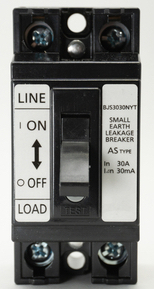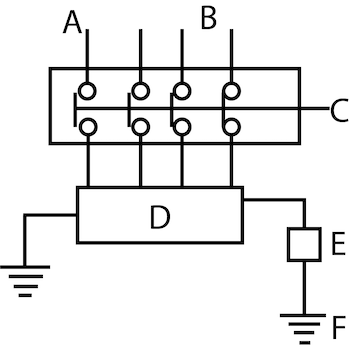Earth Leakage Circuit Breaker

Figure 1: An earth leakage circuit breaker
An Earth Leakage Circuit Breaker (ELCB) helps protect people and equipment from electrical shocks. It detects and stops an electrical current that leaks to earth, meaning the current diverts from its intended path and flows into the ground. ELCBs are found in homes and businesses and are located near the main electrical panel. To ensure electrical safety, they should be checked regularly to ensure they are working correctly. Earth leakage can lead to electrical shock and other electrical hazards.
Table of contents
View our online selection of circuit breakers!
What is earth leakage?
Earth leakage describes an abnormal or unintended state when electrical current leaks from an electrical appliance or circuit to the earth. The following are the most common reasons why earth leakage occurs:
- Insulation failure: Insulation failure (Figure 2) can occur due to age, temperature, or physical damage to the insulation.
- Imperfect electrical connections: Loose or poorly connected electrical joints.
- Poor earthing systems: If the earth connection is not of sufficient quality or resistance, it can cause current to flow to earth.
- Use of faulty equipment: Faulty electrical equipment, such as a damaged appliance, can cause earth leakage.
- Human error: Improper installation can cause earth leakage.
Earth leakage's potential consequences and dangers include electrical shock, fire, and other hazardous electrical incidents. Examples of appliances and circuits prone to earth leakage are refrigerators, washing machines, power tools, and lighting circuits.

Figure 2: A wire with damaged insulating material.
ELCB working principle
There are two types of ELCBs: voltage and current. This section focuses on voltage ELCBs. Current ELCBs are also called residual current devices (RCDs) or residual current circuit breakers (RCCBs). Read our article on RCCBs to learn more.
Voltage ELCBs are older than current ELCBs and may need to be replaced with the latter depending on local regulations. Voltage ELCBs require a ground connection to measure earth leakage, but current ELCBs do not. Also, current ELCBs are more sensitive. These facts make voltage ELCBs less safe than current ELCBs.
Voltage ELCBs

Figure 3: An ELCB working diagram: hot wire (A), neutral wire (B), phase wire (C), load (D), ELCB relay coil (E), and earth (F).
An ELCB continuously measures the voltage difference between power coming from the source through the hot wire and power returning to the source through the neutral wire. Figure 3 illustrates how an ELCB operates:
- Hot wire (A): Current flows from the source, through the hot wire, to the load. On diagrams, this wire is labeled R.
- Neutral wire (B): The neutral wire carries current from the load back to the source. On diagrams, this wire is labeled B or N.
- Phase wire (C): The phase wire carries electricity from the source to the ELCB.
- Load (D): The load is a metal component of the device that ELCB connects to, e.g., a circuit panel door.
- Relay Coil (E): One relay coil terminal connects to the load and the other terminal connects to earth. If the current difference between the hot wire and neutral wire reaches a predetermined value (commonly 50 mA), the current in the relay creates an electromagnetic field strong enough to trip the circuit.
- Earth (F): Connecting one terminal of the relay coil to earth ensures safety by providing a low-impedance path for stray electrical currents.
After the relay coil trips the breaker, the breaker may not reset. This is likely due to current still leaking to the earth. This leakage may come from a piece of equipment connected to the main electrical supply, or it may be coming from the building’s wiring. If unplugging appliances does not fix the issue, contact a licensed electrician.
2, 3, and 4-pole ELCBs
The primary difference between 2-, 3-, and 4-pole ELCBs is how much current can pass through each in any given moment. 2-pole ELCBs can handle enough current for most residential and small commercial buildings. Industrial applications that require more current use 3- and 4-pole ELCBs.
Double pole breakers have two incoming hot wire terminals and two outgoing hot wire terminals, and one neutral wire terminal. A 3-pole breaker has three incoming and outgoing terminals for three hot wires. A 4-pole breaker does as well, but also provides protection for the neutral wire. So if there is an excess current coming from the neutral wire, the 4-pole breaker will trip.
Voltage ELCB limitations
It’s useful to understand voltage ELCBs because older electrical systems may still be using them. However, they are typically considered obsolete in comparison to current ELCBs. Voltage ELCBs do have advantages such as protecting against electric shock, lower sensitivity that results in fewer unnecessary trips, and lower cost. The list of disadvantages outweighs the advantages, though.
- Voltage ELCBs cannot detect leakage from the phase wire to other earthed bodies.
- Voltage ELCBs only trip when current flows through the earth conductor.
- A voltage ELCB will not prevent shock if the phase conductor is directly touched.
- It cannot detect low leakage current due to its lower sensitivity.
For extra protection, it may be necessary to replace a voltage ELCT with a current ELCB (also known as RCD). Consult a professional electrician to determine whether or not this is the case.
ELCB standard
IEC 61008 is an international standard that covers the performance, testing, and labeling requirements of RCDs and ELCBs. It’s essential to ensure an ELCB meets a standard to ensure that it operates correctly. An improperly working ELCB can be fatal.
Read our circuit breaker overview article for more information on the working and types of circuit breakers.
FAQs
What is an ELCB?
An ELCB keeps you safe from electrical shock in electrical systems. It checks for dangerous voltages on metal parts of electrical equipment and turns off the power if it finds any.
Can an ELCB prevent electric shock?
Yes, an ELCB monitors for earth leakages and trips the circuit at dangerous levels.





